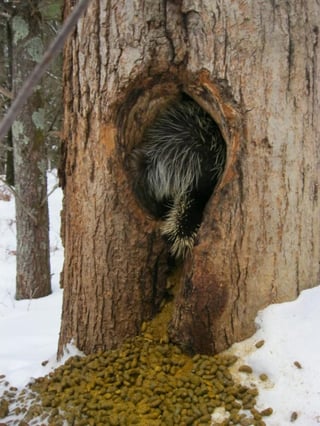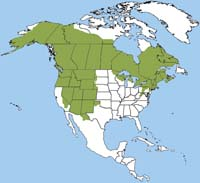UPDATE: I was not paying close enough attention to size. If the feces is as small as the OP mentions in the comment below this post ("20+ of these scat in an acorn"), then this is very unlikely porcupine!! Instead, the size and shape suggests the feces belong to either a rat (perhaps wood rat) or some type of squirrel.
- I await an update form the OP with more specifics before diving deeper...
Hollowed-out tree? Pile of pellet-like feces? End of Winter/start of spring?
Almost assuredly these belong to a porcupine.
Source: user Thomas at http://livingprimitively.com/2012/05/
The North American porcupine (Erethizon dorsatum), which can be found throughout Canada and much of the northern US, is present in New York.
Source: NH PBS
Animaldiversity.org suggests that porcupines are primarily tree dwellers in the state of NY.
- For a suburban example like yours, see here.
Although porcupines do not hibernate, they reduce their range significantly during the winter and will tend to accumulate large piles of scat in and near their winter den (or suite of dens -- source). Although caves are ideal as they keep porcupines warmer, they also will frequently use hollowed-out trees as winter dens.
Since the inner bark of trees is a favorite food of porcupines (source), they will linger quite a bit around their den tree or other nearby trees if available.
Porcupine scat matches what you've found. Scat is oblong, slightly curved, and composed mostly of sawdust (due to their high wood diet) [Source: here]. According to Northwoodguides:
Wood fibers are evident in their scat. Scat may be piles of pellets varying in length from 1/2 to 1 inch long or it may be present in a chainlike pattern connected by wood fibers. Color varies from season to season depending on diet but is usually brown to black.
This site also has some good info, photos, and videos.
It is unlikely your scat belongs to another mammal such as a flying squirrel. Although flying squirrel poop looks similar and is smaller, their feces will not be notable woody as they eat lichens, fungi, berries, leaves, and other non-woody foods. Source. This site suggests that flying squirrel scat can accumulate at the base of a tree, but I have not seen this nor do the other characteristics match your almost textbook example of a porcupine "poop tree."


